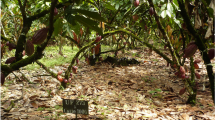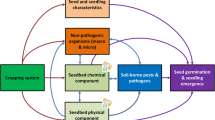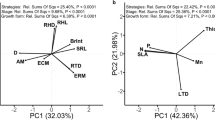Abstract
Seeds of four full-sibling Douglas-fir families (F) were moist chilled (C) for 14, 33, and 77 days and sown (S) March 29, April 26, and May 24 at two densities (D=111 and 200 seeds/m2), grown for 2 years in nursery beds and phenology and size traits recorded. The study was analyzed in two parts: part I evaluated seed treatment effects and their interactions with families; and part II investigated the effect of treatments on genetic variances, particularly among-family (σF 2) and within-plot (σω 2) components and the intraclass correlation for families (t% MathType!MTEF!2!1!+-% feaafiart1ev1aaatCvAUfeBSjuyZL2yd9gzLbvyNv2CaerbuLwBLn% hiov2DGi1BTfMBaeXatLxBI9gBaerbd9wDYLwzYbItLDharqqtubsr% 4rNCHbGeaGak0dh9WrFfpC0xh9vqqj-hEeeu0xXdbba9frFj0-OqFf% ea0dXdd9vqaq-JfrVkFHe9pgea0dXdar-Jb9hs0dXdbPYxe9vr0-vr% 0-vqpWqaaeaabaGaaiaacaqabeaadaqaaqaaaOqaaGqaa0Gaa8NKba% aa!3886!\[f\]). In part I there were large and highly significant differences associated with C and S and among F for all traits. Early S combined with long C resulted in early emergence and gave large seedlings with little loss and damage. Many interactions between C and F, and S and F, were significant. Interactions involved rank changes for size but not for phenology traits, and were larger for C×F than for S×F. Seedling density affected seedling size but not phenology, did not interact with seed treatments, and interacted significantly but weakly with families. In part II, C and S, but not D, had significant effects on σF 2, σω 2, and t% MathType!MTEF!2!1!+-% feaafiart1ev1aaatCvAUfeBSjuyZL2yd9gzLbvyNv2CaerbuLwBLn% hiov2DGi1BTfMBaeXatLxBI9gBaerbd9wDYLwzYbItLDharqqtubsr% 4rNCHbGeaGak0dh9WrFfpC0xh9vqqj-hEeeu0xXdbba9frFj0-OqFf% ea0dXdd9vqaq-JfrVkFHe9pgea0dXdar-Jb9hs0dXdbPYxe9vr0-vr% 0-vqpWqaaeaabaGaaiaacaqabeaadaqaaqaaaOqaaGqaa0Gaa8NKba% aa!3886!\[f\], but not in a predictable manner. Because of significant interactions, it is recommended that standardized seed treatments be used in family nursery tests. This should aid in keeping the results from these tests as repeatable as possible. Long chilling and sowing as early as practicable are recommended to minimize disease losses and winter damages and to provide good nursery stock.
Similar content being viewed by others
References
Alessi, J. and Power, J.F. 1975. Response of an early-maturing corn hybrid to planting date and population in the Northern Plains. Agron. J. 67: 762–765.
Allen, G.S. 1960. Factors affecting the viability and germination behavior of coniferous seed. IV. Stratification period and incubation temperature, Pseudotsuga menziesii (Mirb.) Franco. For. Chron. 36: 18–29.
Barnett, J.P. 1993. Presowing treatments affect shortleaf pine seed germination and seedling development. Tree Planters' Notes 44: 58–62.
Bastien, J.Ch. and Roman-Amat, B. 1990. Predicting Douglas-fir (Pseudotsuga menziesii (Mirb.) Franco) volume at age 15 with early trails. Silvae Genet. 39: 29–35.
Black, J.N. and Wilkinson, G.N. 1963. The role of time of emergence in determining the growth of individual plants in swards of subterranean clover (Trifolium subterraneum L.). Austral. J. Agric. Res. 14: 628–638.
Bloomberg, W.J. 1973. Fusarium root rot of Douglas-fir seedlings. Phytopathology 63: 337–341.
Campbell, R.K. and Sorensen, F.C. 1973. Cold-acclimation in seedling Douglas-fir related to phenology and provenance. Ecology 54: 1148–1151.
Cook, R.E. 1980. Germination and size-dependent mortality in Viola blanda. Oecologia 47: 115–117.
Dormling, I. 1973. Photoperiodic control of growth and growth-cessation in Norway spruce seedlings. IUFRO Working Party 2.01.4, Symposium on Dormancy in Trees. Kórnik, Poland, Sept. 5–9, 1973. 16 pp.
Fowler, N.L. 1984. The role of germination date, spatial arrangement, and neighbourhood effects in competitive interactions in Linum. J. Ecol. 72: 307–318.
Gray, D. 1976. The effect of time to emergence on head weight and variation in head weight at maturity in lettuce (Lactuca sativa). Ann. Appl. Biol. 82: 569–575.
Hammerton, J.L. 1975. Experiments with Cyperus rotundus L. III. Seasonal variations in growth. Weed Res. 15: 339–348.
Heide, O.M. 1977. Regulering av vekst of kvile hos ulike økotyper av gran. (Control of growth and dormancy in Norway spruce ecotypes.), pp. 1–10. In: Dormling, I. and Eriksson, G. (Eds) Experimental Genekologi. Department of Forest Genetics, Royal College of Forestry, Stockholm. Research Note 27. (Swedish with English summary and captions.)
Hicks, C.R. 1982. Fundamental Concepts in the Design of Experiments. 3rd edition. Holt, Rinehart and Winston. New York.
Hühn, M., Kleinschmit, J., Svolba, J. 1987. Some experimental results concerning age dependency of different components of variance in testing Norway spruce (Picea abies [L.] Karst.) clones. Silvae Genet. 36: 68–71.
Jenkinson, J.L. and McCain, A.H. 1993. Winter sowings produce 1–0 sugar pine planting stock in the Sierra Nevada. USDA Forest Serv., Pacific SW Res. Sta., Berkeley, Calif., Res. Pap. PSW-RP-219. 10 p.
Jenkinson, J.L., Nelson, J.A., Huddleston, M.E. 1993. Improving planting stock quality-the Humbold experience. USDA Forest Serv., Pacific SW Res. Sta., Berkeley, Calif., Gen. Tech. Rep. PSW-GTR-143. 219 p.
Johnson, G.R. and Frey, K.J. 1967. Heritabilities of quantitative attributes of oats (Avena sp.) at varying levels of environmental stress. Crop Sci. 7: 43–46.
Lawn, R.J. 1979. Agronomic studies on Vigna spp. in south-eastern Queensland. I. Phenological response of cultivars to sowing date. Austral. J. Agric. Res. 30: 855–870.
Magnussen, S. 1989. Effects and adjustments of competition bias in progeny trials with single-tree plots. For. Sci. 35: 532–547.
Mazer, S.J. and Schick, C.T. 1991. Constancy of population parameters for life-history and floral traits in Raphanus sativus L. II. Effects of planting density on phenotype and heritability estimates. Evolution 43: 1888–1907.
McLemore, B.F. 1969. Long stratification hastens germination of loblolly pine seed at low temperatures. J. For. 67: 419–420.
Miller, T.E. 1987. Effects of emergence time on survival and growth in an early old-field plant community. Oecologia 72: 272–278.
Miller, T.E., Winn, A.A. and Schemske, D.W. 1994. The effects of density and spatial distribution on selection for emergence time in Prunella vulgaris (Lamiaceae). Am. J. Bot. 81: 1–6.
Prout, T. and Barker, J.S.F. 1989. Ecological aspects of the heritability of body size in Drosophila buzzatii. Genetics 123: 803–813.
Rasumov, V.I. 1930. Über die photoperiodische Nachwirkung in Zusammenhang mit der Wirkung verschiedener Aussaatterminen auf die Pflanzen. Planta 10: 345–377.
Robinson, H.F. and Moll, R.H. 1959. Implications of environmental effects on genotypes in relation to breeding, pp. 24–31. Proc. 14th Annual Hybrid Corn Industry Research Conference.
Robinson, J.F. and van, Buijtenen, J.P. 1979. Correlation of seed weight and nurserybed traits with 5-, 10-, and 15-year volumes in a loblolly pine progeny test. For. Sci. 25: 591–596.
Schmidt-Vogt, H. 1995. Einfluß der Umweltbedingungen auf die Jugendentwicklung von Fichten-Provenienzversuchen (Picea abies (L.) Karst.). Allg. Forst- u. Jagdztg 166: 121–127.
Skeates, D.A. 1986. Time of germination: a factor in rate of growth of accelerated transplants of black spruce (Picea mariana (Mill) B.S.P.). Tree Planters' Notes 37(1): 20–24.
Sorensen, F.C. 1978. Date of sowing and nursery growth of provenances of Pseudotsuga menziesii given two fertilizer regimes. J. Appl. Ecol. 15: 273–279.
Sorensen, F.C. 1980. Effect of date of cone collection and stratification period on germination and growth of Douglas-fir seeds and seedlings. USDA Forest Serv., Pacific NW Forest and Range Exp. Sta., Portland, Oregon. Res. Note PNW-346. 11 p.
Sorensen, F.C. 1983. Relationship between logarithms of chilling period and germination or bud flush is linear for many tree species. For. Sci. 29: 237–240.
Sorensen, F.C. 1990. Stratification requirements for germination of western larch (Larix occidentalis Nutt.) seed. USDA Forest Serv., Pacific NW Research Sta., Portland, Oregon. Res. Note PNW-RN-493. 11 p.
Sorensen, F.C. 1991. Stratification period and germination of Douglas-fir seed from Oregon seed orchards: two case studies. USDA Forest Serv., Pacific NW Research Sta., Portland, Oregon. Res. Note PNW-RN-499. 22 p.
Sorensen, F.C. and Campbell, R.K. 1993. Seed weight-seedling size correlation in coastal Douglas-fir: genetic and environmental components. Can. J. For. Res. 23: 275–285.
Tanaka, Y. 1976. Stratification and other pre-treatments of Douglas-fir for nursery germination, pp. 163–173. In: Hatano, K., Asakawa, S., Katsuta, M., et al. (Eds) Proceedings of IUFRO International Symposium on Physiology of Seed Germination. Fuji, Japan.
Tanaka, Y., Kleyn, N.J., Harper, L.M. 1986. Seed stratification of Engelmann spruce and lodgepole pine: the effect of stratification duration and timing of surface-drying. For. Chron. 62: 147–151.
Tranquillini, W., Lechner, F., Oberarzbacher, P., Unterholzner, L. and Holzer, K. 1980. Über das Höhenwachstum von Fichtenklonen in verschiedener Seehöhe. Mitt. der forstl. Bundes-Versuchsanst. Wien. 129: 7–25.
Watson, D.J. and Baptiste, E.C.D. 1938. A comparative physiological study of sugarbeet and mangold with respect to growth and sugar accumulation. I. Growth analysis of the crop in the field. Ann. Bot. 2: 437–480.
Weber, J.C. and Sorensen, F.C. 1990. Effects of stratification and temperature on seed germination speed and uniformity in central Oregon ponderosa pine (Pinus ponderosa Dougl. ex Laws.). USDA Forest Serv., Pacific NW Research Sta., Portland, Oregon. Res. Pap. PNW-RP-429. 13 p.
Author information
Authors and Affiliations
Rights and permissions
About this article
Cite this article
Sorensen, F.C. Effects of length of seed chilling period and sowing date on family performance and genetic variances of Douglas-fir seedlings in the nursery. New Forest 12, 187–202 (1996). https://doi.org/10.1007/BF00027931
Received:
Accepted:
Issue Date:
DOI: https://doi.org/10.1007/BF00027931




